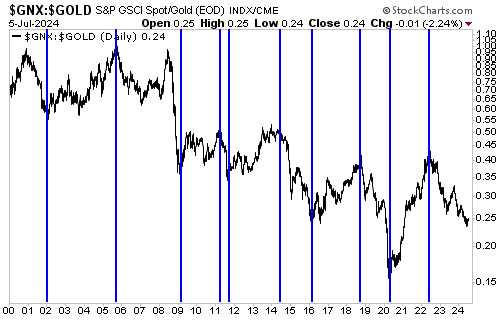[This blog post is an excerpt from a recent commentary at www.speculative-investor.com]
With regard to the topics that we write about regularly, over the past year we have been most wrong about the stock market and the US economy. It’s true that the average stock has not fared particularly well, but we have been consistently surprised by the strength of the S&P500 Index and other large-cap-focussed indices for about 18 months now. Also, we thought that the US economy would be in recession by the end of last year and would be very weak during the first three quarters of this year, but while the US economy certainly slowed during the first half of this year it clearly has not yet entered recession territory. These mistakes are linked, in that major bearish trends in the stock market tend to encompass recessions. Today we’ll discuss, in broad-brush terms, a likely consequence of both the stock market and the US economy performing much better than we expected up until now.
In our opinion it’s not the case that the US economy has avoided a recession, but rather that the current cycle has been elongated.
We use the commodity/gold ratio (the Spot Commodity Index (GNX) divided by the US$ gold price) to define booms and busts, with booms being multi-year periods during which the ratio trends upward and busts being multi-year periods during which the ratio trends downward. The vertical lines drawn on the following GNX/gold chart mark the trend changes (shifts from boom to bust or vice versa) that have occurred since 2000.

It’s not essential that the bust phase of the cycle contains a recession, but it’s rare for a bust to end until a recession has occurred. Usually, the sequence is:
1) The commodity/gold ratio begins trending downward, marking the start of the economic bust period.
2) The economic weakness eventually becomes sufficiently pervasive and severe to qualify as a recession.
3) Near the end of the recession the commodity/gold ratio reverses upward, thus signalling the start of a boom.
Note that it is not unusual for the stock market to continue trending upward after the bust begins, but the stock market always peaks prior to a recession getting underway. For example, an economic bust began in October-2018 but the SPX continued to make new highs until early-2020.
In the current cycle the commodity/gold ratio has been trending downward since the first half of 2022, meaning that the US economy has been in the bust phase of the cycle for a little more than two years without entering recession. While this is much longer than average, it is comparable to what happened during 2005-2009. During 2005-2009, a bust began (the commodity/gold ratio commenced a multi-year downward trend) in Q4-2005, but a recession did not begin and the stock market did not peak until Q4-2007.
Evidence that the US economy is slowing is becoming clearer almost by the week, but a recession probably won’t start any sooner than September of this year and could be postponed, with help from the government and the Fed, until late this year or even early next year. This means that the coming recession probably won’t end any sooner than the second half of 2025 and could even extend into 2026, which has implications for all the financial markets. It’s the implication for the gold market that we are concerned with today.
The US$ gold price tends to peak on a multi-year basis after it has fully discounted the economic, fiscal and monetary consequences of a recession. This usually happens in the latter stages of a recession but before the recession has ended. Therefore, whereas a year ago we were thinking along the lines of the cyclical gold bull market climaxing in the second half of 2024, the current economic cycle’s elongation and the postponing of a recession probably mean that gold’s cyclical bull market will continue until at least the second half of next year.
 Print This Post
Print This Post
